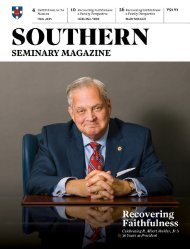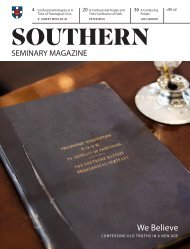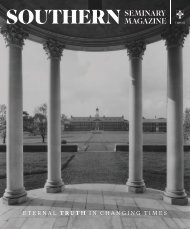Southern Seminary Magazine (Vol 90.1) The Light of Truth: Apologetics in the 21st Century
Create successful ePaper yourself
Turn your PDF publications into a flip-book with our unique Google optimized e-Paper software.
kyle d. claunch<br />
under <strong>the</strong> adm<strong>in</strong>istration <strong>of</strong> <strong>the</strong> Law <strong>of</strong> Moses. <strong>The</strong> Gospel<br />
<strong>of</strong> Luke shows us that Adam’s genealogical l<strong>in</strong>e cont<strong>in</strong>ues<br />
past <strong>the</strong> Old Testament Davidic k<strong>in</strong>gs all <strong>the</strong> way to Jesus<br />
Christ (Luke 3:23–38). <strong>The</strong> eternal Son <strong>of</strong> God, <strong>the</strong> second<br />
person <strong>of</strong> <strong>the</strong> Godhead, assumed a human nature, be<strong>in</strong>g<br />
made like us <strong>in</strong> every way so that he could be <strong>the</strong> one to<br />
make propitiation to God (Heb. 2:14–18). Jesus was everyth<strong>in</strong>g<br />
Adam was, and he succeeded where Adam failed.<br />
<strong>The</strong> apostle Paul makes <strong>the</strong> typological connection between<br />
Adam and Jesus explicit: “<strong>The</strong>refore, as one trespass<br />
led to condemnation for all men, so one act <strong>of</strong> righteousness<br />
leads to justification and life for all men. For as by <strong>the</strong><br />
one man’s disobedience <strong>the</strong> many were made s<strong>in</strong>ners, so<br />
by <strong>the</strong> one man’s obedience <strong>the</strong> many will be made righteous”<br />
(Rom. 5:18–19).<br />
In ano<strong>the</strong>r passage, Paul expounds <strong>the</strong> connection<br />
fur<strong>the</strong>r, say<strong>in</strong>g,<br />
For as by a man came death, by a man has come also<br />
<strong>the</strong> resurrection <strong>of</strong> <strong>the</strong> dead. For as <strong>in</strong> Adam all die,<br />
so also <strong>in</strong> Christ shall all be made alive. . . . Thus it<br />
is written, ‘<strong>The</strong> first man Adam became a liv<strong>in</strong>g be<strong>in</strong>g’;<br />
<strong>the</strong> last Adam became a life-giv<strong>in</strong>g spirit. But it is<br />
not <strong>the</strong> spiritual that is first but <strong>the</strong> natural, and <strong>the</strong>n<br />
<strong>the</strong> spiritual. <strong>The</strong> first man was from <strong>the</strong> earth, a man<br />
<strong>of</strong> dust; <strong>the</strong> second man is from heaven. As was <strong>the</strong><br />
man <strong>of</strong> dust, so also are those who are <strong>of</strong> <strong>the</strong> dust, and<br />
as is <strong>the</strong> man <strong>of</strong> heaven, so also are those who are <strong>of</strong><br />
heaven. Just as we have borne <strong>the</strong> image <strong>of</strong> <strong>the</strong> man<br />
<strong>of</strong> dust, we shall also bear <strong>the</strong> image <strong>of</strong> <strong>the</strong> man <strong>of</strong><br />
heaven (1 Cor. 15:21–22, 45–49).<br />
Jesus Christ is <strong>the</strong> last Adam, <strong>the</strong> one <strong>in</strong> whom we<br />
have redemption from <strong>the</strong> consequences <strong>of</strong> Adam’s s<strong>in</strong><br />
and from <strong>the</strong> consequences <strong>of</strong> our own personal transgressions.<br />
“<strong>The</strong> wages <strong>of</strong> s<strong>in</strong> (Adam’s and ours) is death,<br />
but <strong>the</strong> free gift <strong>of</strong> God is eternal life <strong>in</strong> Jesus Christ our<br />
Lord” (Rom. 6:23).<br />
At this po<strong>in</strong>t, some argue that <strong>the</strong> typological and <strong>the</strong>ological<br />
importance <strong>of</strong> Adam <strong>in</strong> relation to Christ does<br />
not depend on <strong>the</strong> literal historicity <strong>of</strong> Adam. Adam can<br />
simply be a literary figure whose story makes a pr<strong>of</strong>ound<br />
<strong>the</strong>ological po<strong>in</strong>t. Just as I might <strong>in</strong>struct my children<br />
about perseverance <strong>in</strong> hard work by appeal<strong>in</strong>g to “<strong>The</strong><br />
Tortoise and <strong>the</strong> Hare” without imply<strong>in</strong>g anyth<strong>in</strong>g about<br />
<strong>the</strong> historicity <strong>of</strong> <strong>the</strong> fabled race, so Paul (and Hosea) can<br />
appeal to <strong>the</strong> literary story <strong>of</strong> Adam without imply<strong>in</strong>g that<br />
Adam is an actual historical person. This analogy, however,<br />
will not hold up to close scrut<strong>in</strong>y.<br />
In <strong>the</strong> case <strong>of</strong> a literary fable used <strong>in</strong> moral <strong>in</strong>struction,<br />
<strong>the</strong> story is known to be merely illustrative by all who hear it.<br />
<strong>The</strong>re is no history <strong>of</strong> <strong>in</strong>terpretation <strong>of</strong> “<strong>The</strong> Tortoise and <strong>the</strong><br />
“Fundamental to<br />
Christian <strong>the</strong>ology is<br />
<strong>the</strong> happy conviction<br />
that this typological<br />
pattern <strong>of</strong> new Adamlike<br />
figures did not end<br />
with <strong>the</strong> failure <strong>of</strong> <strong>the</strong><br />
Davidic dynasty under<br />
<strong>the</strong> adm<strong>in</strong>istration<br />
<strong>of</strong> <strong>the</strong> Law <strong>of</strong> Moses.<br />
<strong>The</strong> Gospel <strong>of</strong> Luke<br />
shows us that Adam’s<br />
genealogical l<strong>in</strong>e<br />
cont<strong>in</strong>ues past <strong>the</strong><br />
Old Testament<br />
Davidic k<strong>in</strong>gs all<br />
<strong>the</strong> way to Jesus<br />
Christ (Luke 3:23–38).”<br />
Hare” that ascribes to it a literal sense. On <strong>the</strong> o<strong>the</strong>r hand,<br />
<strong>the</strong> vast majority <strong>of</strong> <strong>in</strong>terpreters <strong>of</strong> Genesis 2–3—ancient<br />
and modern, Jewish and Christian—have understood<br />
Adam and Eve to be literal, historical people. Indeed, even<br />
those <strong>in</strong>terpreters who deny <strong>the</strong> historical existence <strong>of</strong> a<br />
literal Adam (such as Peter Enns 1 and Denis O. Lamoreux<br />
2 ) have admitted that <strong>the</strong> apostle Paul and even Jesus<br />
summer 2022<br />
13






